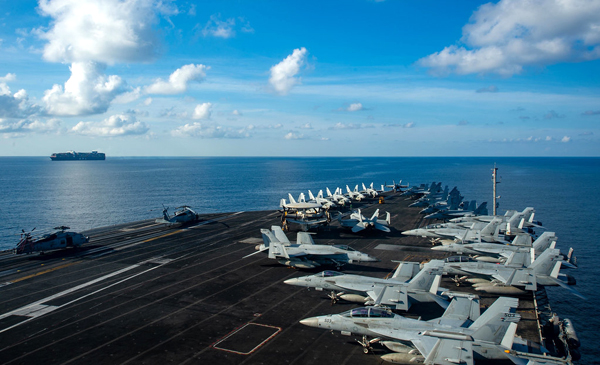USS Ronald Reagan Carrier Strike Group Returns to South China Sea

The USS Ronald Reagan and its Carrier Strike Group returned to the South China Sea on September 24 for the second time during its 2021 deployment. The return of the Navy's only forward-deployed aircraft carrier to the politically charged region comes as the United States has sought to maintain a highly visible presence in the South China Sea.
China recently increased activity in the region, which along with the announcement of new maritime regulations that China said it planned to impose in areas it considers national waters have drawn attention to the South China Sea. Earlier this week at the United Nations General Assembly fears were voiced over a renewed Cold War between the United States and China, while President Biden and Chinese leaders sought to downplay the issues.
The carrier strike group which returned to the South China Sea today includes the USS Ronald Reagan as well as the embarked Carrier Air Wing 5, and embarked staffs of Task Force 70 and Destroyer Squadron 15. Also in the group is the Ticonderoga-class guided-missile cruiser USS Shiloh.
While in the South China Sea, the U.S. Navy announced the strike group will conduct fixed and rotary-wing flight operations, maritime strike exercises, anti-submarine operations, and coordinated tactical training. “The strike group will work with its network of partners and alliances to ensure maritime security and a free flow of commerce in the Indo-Pacific.”
“Ronald Reagan and all components of its strike group have operated with relentless energy and commitment throughout the deployment, showcasing the strength and resilience of America,” said Capt. Fred Goldhammer, Ronald Reagan’s commanding officer. “As we continue our mission in the South China Sea, we remain vigilant and ready to answer the call.”

USS Ronald Reagan and its Air Wing returned to the South China Sea on September 24 (U.S. Navy/MC3 Askia Collins)
The strike group returned to the South China Sea after being assigned to conduct naval operations in U.S. 5th Fleet. The Carrier Air Wing 5 provided air support for U.S. and coalition forces during the drawdown operations from Afghanistan.
“We look forward to leveraging our recent out-of-area experience as we return to the South China Sea and our rapidly growing alliances and partnerships dedicated to the Indo-Pacific,” said Rear Adm. Will Pennington, commander, Task Force 70, Carrier Strike Group 5. “The deployment of Ronald Reagan Carrier Strike Group to the Middle East and rapid seamless return to the Pacific highlight the flexibility and responsiveness of a premier maritime force and the power and reach of global coalitions dedicated to the stability provided by international law and rules-based order."
Highlighting the deployment into the South China Sea, the U.S. Navy said, the operations were “in support of a free and open Indo-Pacific region. U.S. 7th Fleet conducts forward-deployed naval operations in support of U.S. national interests in the Indo-Pacific area of operations.”
At the beginning of September, the 7th Fleet conducted a series of exercises in the South China Sea. The USS Benfold transited the South China Sea and sailed within 12 miles of Mischief Reef, a portion of the Spratly Islands, that China is asserting are within its territorial waters and subject to the new maritime rules. China responded condemning the U.S. actions as aggressive, while the U.S. Navy said the destroyer was conducting routine underway operations in international waters. Days earlier, China had also protested when the Arleigh Burke-class guided-missile destroyer USS Kidd accompanied by the U.S. Coast Guard National Security Cutter Munro conducted transited the Taiwan Strait.
